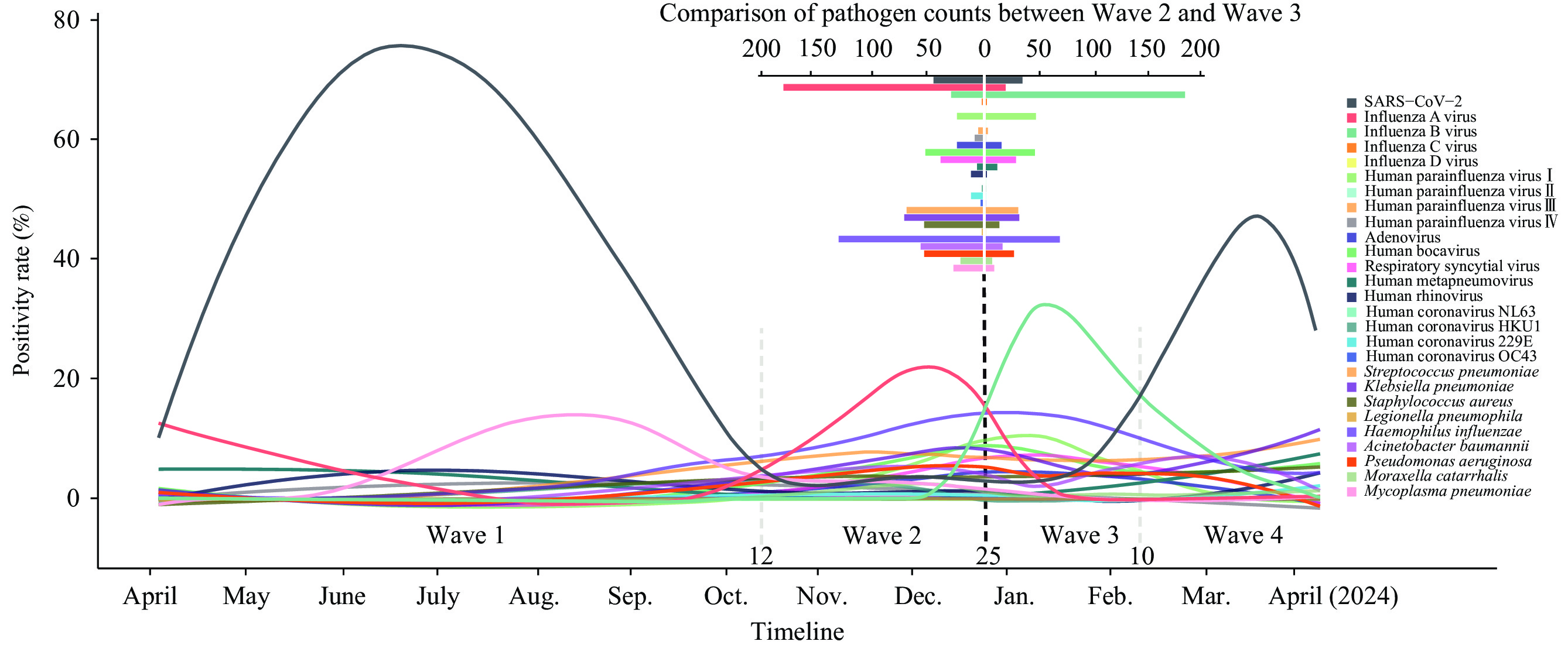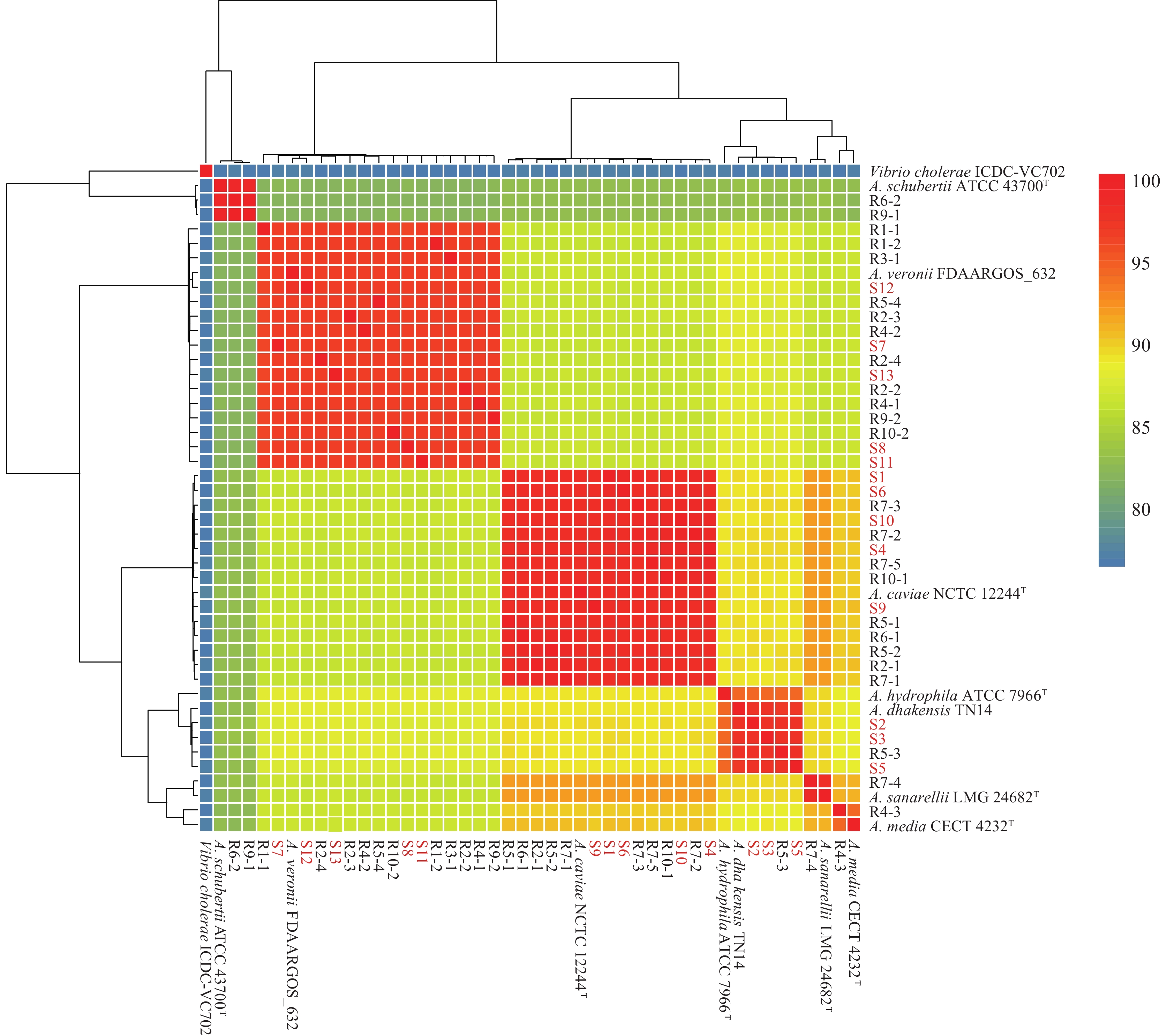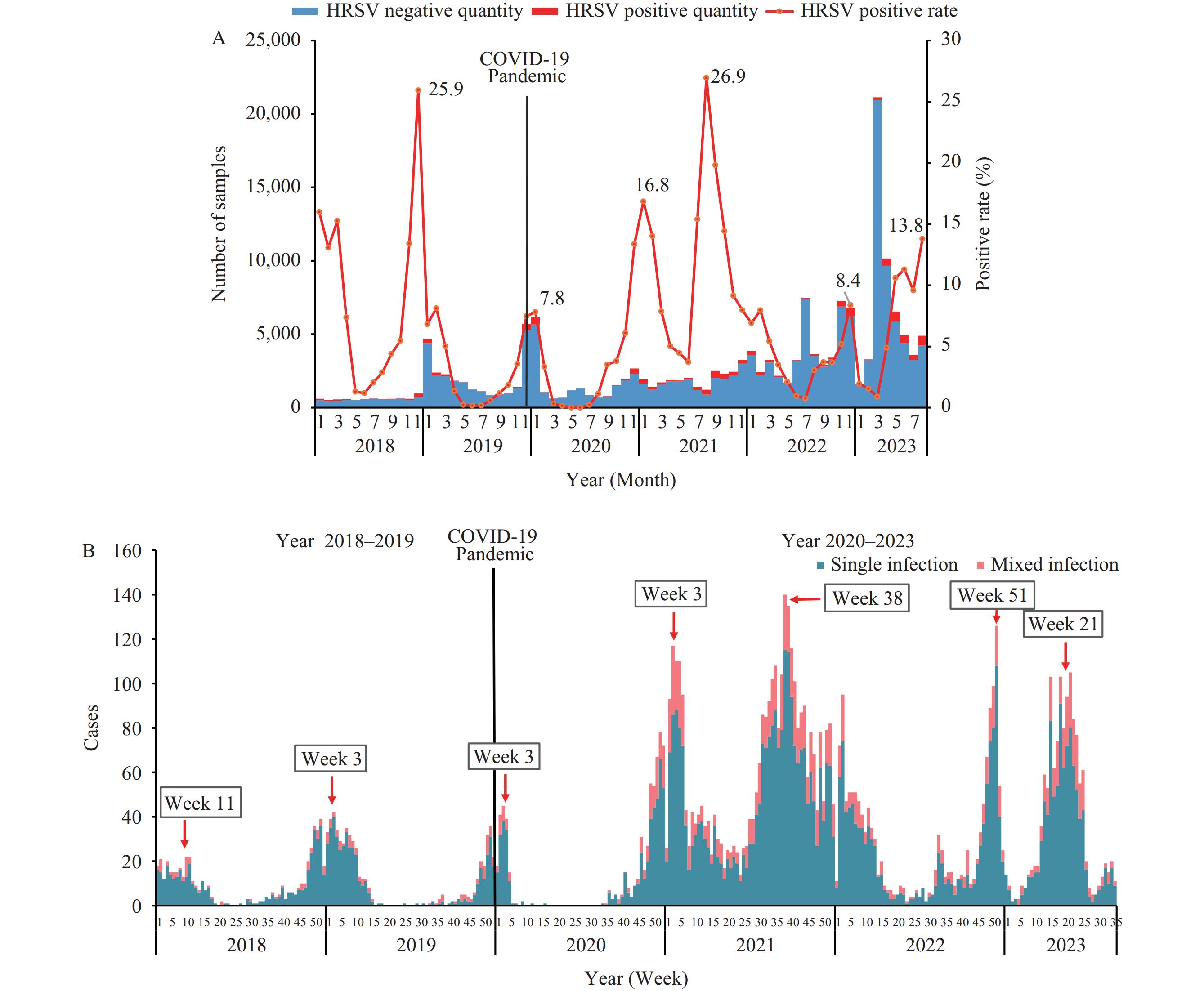2025 Vol. 7, No. 4
Respiratory pathogens pose a complex challenge for public health systems. In the winter of 2023, multiple respiratory pathogens showed staggered epidemic waves. Additionally, co-infections involving various pathogens were observed, resulting in significant disease burdens. Understanding the epidemiological dynamics of these pathogens is essential for supporting public health systems in the prevention and control of respiratory infectious diseases.
Respiratory samples were collected from patients in Beijing presenting with influenza-like symptoms to detect 27 respiratory pathogens using multiplex qPCR.
Four distinct epidemic waves were identified. The first wave was a pre-winter outbreak of Mycoplasma pneumoniae (M. pneumoniae). This was then followed by successive waves of influenza A and B viruses. Severe acute respiratory syndrome coronavirus 2 (SARS-CoV-2) exhibited a resurgence by the end of February 2024. Age-dependent susceptibility varied, with SARS-CoV-2 and influenza A/B peaking in the 30-40-year age group. Conversely, adenovirus, rhinovirus, M. pneumoniae, Moraxella catarrhalis (M. catarrhalis), and Haemophilus influenzae (H. influenzae) were more common in adolescents and the elderly. Furthermore, 18.8% of cases were identified as co-infections with more than two pathogens. H. influenzae was found to frequently co-infect with viral and bacterial pathogens.
Respiratory pathogens exhibited different prevalence trends during the first influenza season following the COVID-19 pandemic. Influenza viruses showed a higher peak incidence and delayed seasonality. Moreover, the co-circulation of viral and bacterial infections increased the complexity of respiratory infections. Interestingly, staggered epidemic waves between SARS-CoV-2 and influenza A/B viruses were observed. Consequently, SARS-CoV-2 may become a seasonal virus, causing epidemics alongside influenza viruses. However, further research is needed to elucidate its epidemiological patterns. The co-circulation of these epidemic viruses and other respiratory pathogens underscores the need for enhanced diagnostic and intervention strategies, including vaccination campaigns.
Aeromonas is widely distributed in aquatic environments. This study describes the pathogenic characteristics of Aeromonas isolated from adult diarrhea patients and aquatic environments in Beijing, China.
Aeromonas isolates from patients with diarrhea and river water samples were assessed using whole-genome sequencing (WGS) and antibiotic resistance profiling.
In total, 38 Aeromonas isolates were collected. Among these, 13 isolates were from patients with common clinical symptoms, including diarrhea, abdominal pain, and nausea. Four of 13 Aeromonas-positive patients were co-infected with other intestinal pathogens. Patient-derived Aeromonas isolates showed high resistance to ampicillin, ampicillin-sulbactam, nalidixic acid, and tetracycline, whereas water-derived isolates showed high resistance to ampicillin, ampicillin-sulbactam, and nalidixic acid. Phylogenetic analysis revealed seven independent branches, without significant clustering among patient- and water-derived isolates.
This study provides valuable insights into the prevalence and characteristics of Aeromonas. The intertwined distribution of patient- and water-derived isolates in the phylogenetic tree deserves attention.
The number of reported cases of human brucellosis significantly increased from 45,046 (3.25/100,000) in 2019 to 70,439 (4.99/100,000) in 2023.
Human brucellosis continued to spread and expand of in northern China, with the most cases reported in the Inner Mongolia Autonomous Region (n=87,961), Xinjiang Uygur Autonomous Region (n=27,845) and Shanxi Province (n=21,932). In southern China, reported cases increased substantially from 2,036 in 2019 to 5,128 in 2023. Joinpoint regression analysis revealed an upward trend in incidence rate across 29 provincial-level administrative divisions (PLADs), with an annual percent change (APC) of 12.86, (P<0.05), with particularly rapid increases observed in most southern PLADs. Spatiotemporal analysis identified high-risk clusters concentrated in the northwestern and northeastern regions.
With the continued worsening of human brucellosis over the past five years, implementing strict controls on the movement of infected animals is urgeent.
Human respiratory syncytial virus (HRSV) coinfection with other respiratory pathogens frequently occurs in young children with acute respiratory illness. However, the epidemiological patterns and associated disease burden of HRSV coinfections in pediatric populations remain poorly characterized.
Analysis of hospitalized children under 5 years in Zhejiang Province from 2018 to 2023 revealed that 20.4% experienced HRSV coinfections, with bacterial coinfections substantially exceeding viral coinfections (14.1% vs. 5.3%). M. pneumoniae and S. pneumoniae emerged as predominant bacterial copathogens, while human rhinovirus and cytomegalovirus were the most prevalent viral coinfection agents. HRSV coinfections were associated with significantly higher disease burden compared to HRSV monoinfection [median expense: 4,971.4 Chinese Yuan (CNY) vs. 4,649.1 CNY; P<0.05].
Implementation of comprehensive prevention strategies, including vaccination programs, nonpharmaceutical interventions, and enhanced surveillance of multiple respiratory pathogens, is essential to reduce HRSV coinfections and their associated disease burden during periods of high respiratory pathogen circulation.
Brucella spp. are facultative intracellular bacteria that can infect many species of animals and humans.
The global Brucella demonstrates distinct territorial distribution patterns: B. abortus predominantly in Africa and North America, B. melitensis dominates in Asia and Europe, and B. suis is most prevalent in Europe. B. melitensis exhibits the highest host and genotype diversity, with most strains isolated from human cases, indicating persistent animal reservoirs and repeated human transmission. Brucella spp. demonstrates region-specific lineage distributions: African B. abortus strains cluster within abortus B lineage, while Asian, American, and European strains group within abortus C. Eastern Mediterranean B. melitensis strains show predominant distribution across Asia and Europe, while B. suis strains display genetic heterogeneity across different geographical regions.
While B. melitensis represents a global public health challenge, B. abortus and B. suis pose more localized concerns. Implementation of livestock brucellosis control programs is essential for reducing human health risks.
This study presents empirical evidence from the implementation of an automated infectious disease warning system utilizing multi-source surveillance and multi-point triggers in Yuhang District, Hangzhou City, Zhejiang Province, so as to provide reference for more extensive practice of infectious disease surveillance and early warning in the future.
The data were obtained from the Health Emergency Intelligent Control Platform of Yuhang District from January 1 to April 30, 2024, encompassing warning signal issuance and response documentation. Descriptive epidemiological method was used to analyze the early warning signals.
From January 1 to April 30, 2024, the Health Emergency Intelligent Control Platform in Yuhang District generated 4,598 valid warning signals, with a warning signal positive rate of 36.43%. The early warning system detected 71 infectious disease outbreaks reported through the Intelligent Control Platform, including 24 single-source early warning and 47 multi-source early warning. The sensitivity was 78.02%, demonstrating improved performance compared to existing infectious disease surveillance and warning systems.
This represents the first domestic publication evaluating an automated multi-source surveillance and multi-point trigger warning system. By integrating and correlating multi-source data, the system can efficiently and accurately detect warning signals of infectious disease incidents, which has significant practical implications for early surveillance, warning, and management of infectious diseases.



 Subscribe for E-mail Alerts
Subscribe for E-mail Alerts CCDC Weekly RSS Feed
CCDC Weekly RSS Feed



